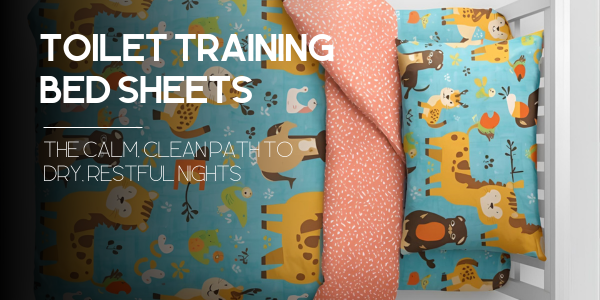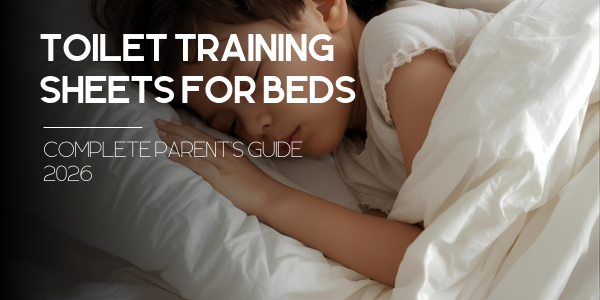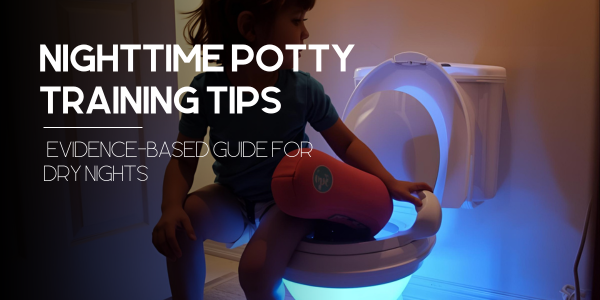Potty Training Power Struggles: The Dignity-First Playbook for Parents & Kid
Potty Training Power Struggles: A Dignity-First Playbook
If potty time feels like a tug-of-war, you’re not failing—you’re human. Here’s a calm, science-backed plan to lower the pressure, protect the bed, and help your child build real skills—on daytime and nighttime timelines that actually match development.
TL;DR — Quick Wins When “Go Now!” Becomes a Standoff
- Lower the stakes: Neutral tone, tiny choices, and a supportive setup beat pressure every time.
- Mind the mismatch: Daytime readiness usually arrives before nighttime dryness—totally normal. :contentReference[oaicite:0]{index=0}
- Guard sleep & dignity: Use discreet, washable waterproof layers while skills mature; punishment backfires. :contentReference[oaicite:1]{index=1}
- Evidence works: Enuresis alarms can help motivated, older kids over time. :contentReference[oaicite:2]{index=2}
Stats that calm the room: ~5–10% of 5-year-olds and up to ~15% of 7-year-olds still wet at night. Most grow out of it—shame doesn’t speed biology. :contentReference[oaicite:3]{index=3}
“If You’re in a Tug-of-War, You’re Not Alone”
Power struggles usually bloom where control meets anxiety. Add a ticking clock, a wet sheet, and a tired parent—boom. Reality check: nighttime dryness lags daytime control for many kids, and family history matters. Boys are affected more often than girls. None of this is a character flaw; it’s development.
Want a deeper primer you can share? Our positive guide to bedwetting in children keeps the tone kind and forward-looking.
What’s Really a “Potty Training Power Struggle”—and What’s Not
Power dynamics vs. readiness mismatch
Power struggle: your capable kid resists; your urgency spikes; everybody locks up. Readiness mismatch: your child simply isn’t ready yet. The AAP urges parents not to force training before behavioral, emotional, and developmental signs are in place. :contentReference[oaicite:5]{index=5}
Readiness signals (daytime)
- Dry ~2 hours in the day; dry after naps
- Recognizes “gotta go” cues; can follow simple steps
- Walks to bathroom; can help undress
Checklist rooted in AAP guidance. Provide a footstool so feet are braced. :contentReference[oaicite:6]{index=6}
What isn’t a power struggle
- New bedwetting after six months dry → talk to your pediatrician
- Painful urination, extreme thirst/urination, snoring/daytime sleepiness
These are medical red flags—don’t “discipline” biology.
Bookmark our evidence-based potty training fact sheet for quick answers when relatives (lovingly) apply pressure.
Science Parents Can Use (a fast credibility boost)
Constipation is a stealth player
Constipation and enuresis often travel together. Treating constipation alone resolves bedwetting for many kids—because bowel pressure affects bladder signaling and capacity. Said simply: softer stools, calmer nights. :contentReference[oaicite:8]{index=8}
Alarms aren’t magic, but they’re legit
Motivated, older kids can benefit from enuresis alarms. High-quality reviews suggest alarms beat no treatment and may offer better long-term dryness than meds alone—when families stick with them. :contentReference[oaicite:9]{index=9}
Never punish bedwetting
Punishment and shaming don’t teach bladder-brain coordination and can harm a child’s confidence. If nighttime accidents persist into the late teens, that’s a time to see your doctor. :contentReference[oaicite:10]{index=10}
Traffic-Light Triage: Is It Power, Readiness, or Red-Flag?
| Zone | What You See | First Move |
|---|---|---|
| GREEN | Capable child, occasional resistance; soft stools; no pain | Neutral scripts, choices, routine sits, footrest |
| YELLOW | Persistent resistance despite low pressure | Pause for 2–8 weeks; come back later—protect the relationship. :contentReference[oaicite:12]{index=12} |
| RED | New wetting after 6+ months dry; pain; excessive thirst/urination; snoring/daytime sleepiness; UTIs | See your pediatrician; rule out medical drivers. :contentReference[oaicite:13]{index=13} |
If “rubber sheets” are making everyone miserable, here’s why to skip rubber sheets for bed wetting and what to use instead.
7-Day Power-Struggle Reset (Doable, not perfect)
Day 1–2: Declutter pressure
- Swap “Go now” for two choices (blue potty or white potty?).
- Keep wins low-key: “Nice try—flush, wash, done.”
Day 3–4: Body-clock support
- Front-load fluids earlier; light liquids 2–3 hours before bed.
- Place calm sits after meals to ride the gastrocolic reflex.
- Support soft stools (fiber, fluids)—stool withholding fuels battles.
Day 5: No-shame night plan
Separate day learning from night protection. Guard sleep now with a discreet, washable waterproof layer so confidence can grow. (That’s the whole game.)
Shop Chooniez Bedwetting Throw Blanket →
Day 6: Scripts, not bribes
- “Looks like your body’s talking. Potty now or in two minutes?”
- “Accidents are data, not drama. Change, reset, move on.”
Day 7: Review and decide
If strain creeps back, that’s your cue to pause for a few weeks. Progress isn’t linear—and you’re still winning because the relationship comes first. :contentReference[oaicite:15]{index=15}
Need inspiration? See why bed wetting sheets are game-changers and how to use bed pads for incontinence without the crinkle.
Nighttime ≠ Daytime (Two tracks, same kid)
Day skills are about habits and readiness. Night dryness requires brain-bladder signaling that often matures later—very often beyond age five. Most kids outgrow bedwetting on their own; shaming delays nothing. :contentReference[oaicite:16]{index=16}

“As kids get older—6 to 8—they can feel embarrassed. Our job is to protect sleep and self-esteem while the body learns.” :contentReference[oaicite:17]{index=17}
Talking point for your kid: try our family script from how to talk to kids about bed wetting.
For motivated older kids, explore how bed-wetting devices and alarms work alongside gentle routines. Evidence supports alarms over no treatment for many families. :contentReference[oaicite:18]{index=18}
Say This, Not That (copy-ready scripts)
Co-regulation
Say: “Your body’s telling you it’s time. Potty now or in two?”
Not: “If you don’t go, no TV.”
Accidents
Say: “Bodies learn in steps. Let’s change, then try later.”
Not: “You’re too old for this.”
Night wets
Say: “Your brain and bladder are still learning at night. Your bed’s protected. You’re safe.”
Not: “This is ridiculous.”
Curious what’s actually inside modern waterproof layers? Here’s our take on innovative bed sheets for bed wetting and why they’re quieter, softer, better.
Buyer’s Guide: Dignity-First Night Protection
What to look for (and why it matters)
- Soft top (no “hospital” vibes), discreet appearance, fast wash/dry cycles
- True waterproof barrier (not just “resistant”), couch-to-bed versatility
- Kid-approved comfort so they own the process
Our two most-loved setups
1) Quick-swap throw (minimal laundry)
Layer a soft, waterproof throw over the sheet. If there’s an accident, swap the throw in 30 seconds. No drama, no blame.
Why parents are moving beyond towels: see the waterproof blanket for bed wetting guide.
2) Zip-in sleeping bag (travel/sleepovers)
For trips or couch nights, a washable, waterproof sleeping bag keeps the vibe fun and the cleanup easy.
Nerding out on options? Compare reusable vs. disposable bed pads, learn how to clean a mattress, and see why rubber sheets for potty training often backfire.
Ready for calm nights? Our discreet, kid-approved throw keeps sheets dry while confidence grows.
FAQ (the questions parents actually Google)
How do I end a potty training power struggle fast?
Lower the stakes (neutral tone + two choices), optimize the setup (footrest for leverage), and follow the 7-day reset. If tension spikes, pause; forcing backfires. :contentReference[oaicite:19]{index=19}
Is bedwetting a sign potty training failed?
No. Night dryness is a separate developmental track; many kids are not reliably dry at night until later. Protect sleep, keep shame out of it. :contentReference[oaicite:20]{index=20}
Do bedwetting alarms really work?
They often help older, motivated kids compared with no treatment, especially for long-term dryness. They’re not instant; consistency matters. :contentReference[oaicite:21]{index=21}
When should I see a doctor?
New bedwetting after 6+ months dry, painful urination, extreme thirst/urination, daytime sleepiness with snoring, or recurrent UTIs—all warrant a pediatric visit. :contentReference[oaicite:22]{index=22}
What else can I read right now?
Try our nighttime potty training guide, the potty training blanket guide, and this primer on quiet, washable nighttime pads.
Power-Struggle Toolbox: Read, Try, Share
- Take the potty training readiness quiz to see if it’s time—or time to pause.
- Gentle fixes for a toddler resisting potty training (and everyone still sleeps).
- Why washable incontinence bed pads are trending with real families.
- Confidence boosters: potty training bed pads protect confidence.
- Make it playful with science-based potty games.
Bottom Line
Power struggles melt when pressure does. Keep the tone calm, the setup supportive, and the bed protected. You’re raising a human, not running a stopwatch. If you want to go deeper into materials, tech, and design choices, explore our perspective on innovative bed sheets or browse the rest of Chooniez.







Leave a comment